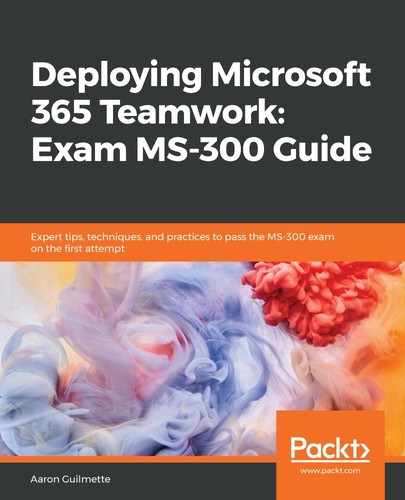As mentioned previously, Teams is framed as a hub for getting work done. From a collaboration perspective, the following components go into making a Team:
- An Office 365 Group (either creating a new group or converting an existing group)
- A SharePoint Online site (part of the Office 365 Group)
- An Exchange Online group mailbox and calendar (also part of the Office 365 Group)
- A OneNote notebook (part of the Office 365 Group)
- Endpoints and connectivity to other first-party apps such as Planner and Power BI
Teams can be accessed through a web browser, a rich client, or mobile apps. When you launch Teams (either the web interface or the desktop client app), you'll see an interface similar to the following screenshot:

We'll quickly run through an overview of the interface. As users will likely spend most of their time in the Teams section, we'll look at what is presented there:
- App Bar: The App Bar is a navigation menu that allows you to access the sections of Teams. In some documentation, though, it's also referred to as the Left Rail. From the top, notice the following icons:
- Activity: This is where you'll find @mentions, replies, and other updates or notifications.
- Chat: This section displays your recent individual and group chat messages, as well as your contact list.
- Teams: The Teams section shows all of the Teams you're in. Teams can be shown or hidden.
- Calendar: Calendar items are synchronized with Outlook. From the Calendar section, you can see your week at a glance and join or create meetings.
- Calls: The Calls section allows you to make calls to individuals (either PC-to-PC calling or to the PSTN network if you are licensed for it). You can also see your contacts, call log, and access your voicemail (if you have the appropriate licensing).
- Files: The Files section shows an aggregated view of the files from all your Teams, as well as your personal OneDrive for Business and other connected cloud storage providers such as Box, Google Drive, or DropBox.
- [...]: The ellipses expands to display links to apps that are connected to Teams.
- Apps: The Apps section opens the Teams App Store where you can acquire and install bots, apps, and other services that can be integrated into Teams.
- Help: The Help icon opens the Teams documentation.
- Download: The download icon allows you to download the Teams desktop client.
- Teams: When you access the Teams section (as selected in the preceding screenshot), you'll notice a list of Teams that you can access, as well as the Join or Create a Team button.
- Team: The core individual component of Microsoft Teams is a team. A team is composed of Channels, which can act like folders in order to organize different content areas of a team. For example, if you are part of a team working on a particular vehicle model, you might have a channel for the various components such as Doors, Wheels, Glass, or Engine.
- Tabs: Tabs are used to organize content inside of a channel. When you create a new Team, by default, channels are created for Conversation, Files, and Wiki. You can add additional tabs by clicking the + button. Different options may be available depending on your region or whether you are using one of the Microsoft sovereign clouds (such as the Government Community Cloud or 21Vianet).
- New Chat Button: The New Chat button can be used to start an instant message conversation.
- Command Bar or Command Box: The command bar or command box is a multi-purpose bar that can be used for shortcuts to commands or searching for content in Teams.
- Compose Box: This is where you'll compose messages for a conversation.
- Send Button: After you've entered a message in the compose box, click the Send button to post it.
Now that you have some familiarity with the Teams user interface, let's move on to the administration side.
